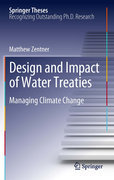
This study presents a unique way to utilize the existing literature to explain the success of treaties in managing hydrologic stress. Literature-derived core concepts are summarized as seven treaty mechanisms categories (specificity,uncertainty management, enforcement, communications, flexibility, integrativeness, and scale) and are hypothesized as important for shaping the institutional resiliency of a treaty. Treaty design is shown to have a relevant and important role in shaping basin management so that nations may better achieve theirgoals in a changing climate. Nominated by Oregon State University for a Springer Theses Prize. Includesa thorough literature review on the relationship between international conflict and changes in climate. Numerous case studies are discussed, including the Nile and Helmand River Basins. INDICE: Introduction. Literature Review. Hypotheses, Definitions, and Explanatory Mechanisms. Data and Methods: Treaties, Power, Scarcity, and Conflict.Results. Case Studies-Application of the Results. Conclusions.
- ISBN: 978-3-642-23742-3
- Editorial: Springer Berlin Heidelberg
- Encuadernacion: Cartoné
- Páginas: 213
- Fecha Publicación: 31/10/2011
- Nº Volúmenes: 1
- Idioma: Inglés
